Formal analysis: formal analysis is breaking down the entire film into its separate parts and talking aout how each part contributes to the whole of the film. By breaking down the film you would talk about how lighting, casting, sound design, cuts, cinematography all individually effect the film as a whole and how they all collectedly effect the film. To be well in formal analysis you must understand each part of the film, you kmust understand the concepts of editing and cinematography and how they can effect a film then you must say how they do effect the film that your are writing about.
Film history: there are three types of writing in film history. The production history, in the production history you can see the planning that went into the film, you can look at the production of the film, the screenings the directors did before they shot, how they shot the film and so on. It focus on the history of how the film was made, the steps and process of producing the film. You can alsow rite about hte release histories of the film. who they were released to where they were released to and why they were banned in certain places. You can look at the history of the audience and their accptance or refusal of that type of film. THen there is film history, or the history of film. Here you would write about how the film lies in the large context of the history of film, where it lies in the evolution of its genre how succesful it was during that time period why it is a famous film and so on.
Ideological writing: ideological writing focus on the ideas and themes within the film. Writing about this means you need to take the overall message from the film and talk about that. Even films that are made soley to entertain have themes and messages in them. Ideological writing focus on bringing out the themes and talking about how they effect the film and how the time period effects the theme and film itself.
cultural studies: this writing talks about the culture in which the film was produced. The writing will examply the values and ideas of the nation from which it was produced. Looking at an American made film, one could see the need for action and testosterone pumping along with the need for good to triumph over evil, but watching films were are foreign to might confuse us as we will not know there values as a nation or understand all of the techniques they use.
Discussion of auteur: writing about this looks as the finished product as the work of a single person. mainly the diector. Here it will show the orginaial vison that the director had versus the product that they produced. problems that come up during this writing are that a movie is not the work of a single person, it is the work of a collaboration of people and studying one person will not give a full insight towards the finished product of the film.
Anotating a film sequence: this means to take short abreviated notes of the camera movements. To note that it starts in an establishing shot, to a close up then reverse shot. Taking notes about the shots will help to notice patterns in the film and note how they move the camera and find the meaning behind these camera movements.
Think beyond the frame: when she says think beyond the frame she wants you to think not only about what is happening in the shot now, but rather what went into making that shot. What is the production of the set. what do critics say about this film and why. What were the makers of the films vision. what happened to be able to make the shot what it was. The movie was not jsut what is on the screen it has many more elements that went into its production, those are the most important things to note.
Andrew's Blog
Sunday, January 27, 2013
Thursday, January 10, 2013
silent to studios
sound was first brought into films by the Warner brothers company. Before they decided to use sound the idea of making films with sounds appalled many other studious. It did so because adding sound would for one mean the production of movies would become more expenisive and that the studios would need to build sound rooms. Also many of the major stars were not strong speakers and their voices would not fit the film aliases that audience were used to. Warner brothers added sound to their movies because they were not doing well money wise and needed something that would keep them afloat and sound might just do that. When they added sound people lined up around blocks to buy tickets for a film with sound. Seeing the success of Warner Brothers the other studios had no choice but to add sound as well. Because sound was added many of the famous stars had to go to voice and diction lessons if they wanted to keep there jobs as actors. Many actors left the bussiness as they couldnt make the transitions. Also thousadns of musicians were laid off because they no longer needed to play the background music for films as the music only had to be recorded once. Sound also affected the production and style of music. Movies became boring and unimaginative because simply having sound was enough to have audience buy tickets. Also shots lost their old creativity as the Cameras couldn't move as they were incased in sound proof boxes to stop the microphone from picking up the noise of the camera. shots were static and not as detailed as actors had to be close to the microphone and there was only one microphone.
Many studios during the 1930-1950's adopted a factory sytme in which they produced films. From this sytem they had all mempers of production under contract for however many films they were to produce and those members were not allowed to work for any other studio without their original studios permission. This factory system allowed for studios to produce quality films in a well organized factory like system. However the factory system did have some dark sides. Many studios adopted a policy called block booking. This policy had theaters taken in many low quality films in order to be able to show the few high quality films. It was one of the ways the Studios tried to gain control over the film empire. Another way was Blind bidding, where smaller chains would bid on unfinished products from the major studios.
Many studios during the 1930-1950's adopted a factory sytme in which they produced films. From this sytem they had all mempers of production under contract for however many films they were to produce and those members were not allowed to work for any other studio without their original studios permission. This factory system allowed for studios to produce quality films in a well organized factory like system. However the factory system did have some dark sides. Many studios adopted a policy called block booking. This policy had theaters taken in many low quality films in order to be able to show the few high quality films. It was one of the ways the Studios tried to gain control over the film empire. Another way was Blind bidding, where smaller chains would bid on unfinished products from the major studios.
Monday, December 3, 2012
narrative: The narrative excels because it highlights the main parts of the films narrative without giving away the ending or all of the rising action or climax.
The plot is, theres a normal family, the zombie Apocalypse starts. they escape and learn to fight them, the government wants the main character to fight for them, he says he wont leave his family and will come back for them, then the rest of the movie he wants to get back to his family
Normal family:
apocalypse starts:
learn how to fight:
Government asks him to fight:
fighting to get back to family:
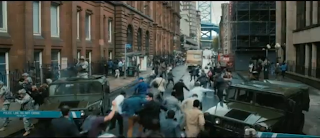 mis en scene: The mis encene was very compelling because it highlighted the amount of chaos and terror a zombie would apocalypse would be. It showed how many people would be running around crazy like, them military coming in to try to stop it. It also just shows the ultimate terror that a lot of zombies would bring to the world. It demonstrates how much chaos would be involved in this scenario. it overall shows the genre of film, a type of action survival movie.
mis en scene: The mis encene was very compelling because it highlighted the amount of chaos and terror a zombie would apocalypse would be. It showed how many people would be running around crazy like, them military coming in to try to stop it. It also just shows the ultimate terror that a lot of zombies would bring to the world. It demonstrates how much chaos would be involved in this scenario. it overall shows the genre of film, a type of action survival movie.
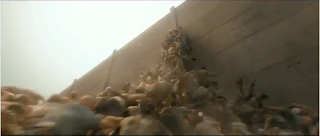 the cinematography of the film does a fine job at showing the nature of the film . This shit for example shows a lot of zombies all trying to climb their way up a ladder. The shot starts of at the top of the ladder with one zombie and slowly moves its way down revealing more and more zombies as they all funnel their way up the ladder. The shot makes the trailer successful because it is awe-inspiring it shows the overall action that the film will hold inside of it.
the cinematography of the film does a fine job at showing the nature of the film . This shit for example shows a lot of zombies all trying to climb their way up a ladder. The shot starts of at the top of the ladder with one zombie and slowly moves its way down revealing more and more zombies as they all funnel their way up the ladder. The shot makes the trailer successful because it is awe-inspiring it shows the overall action that the film will hold inside of it.
The edit does a good job at highlighting the action of the film. The edit shows the overall theme of action by connecting multiple shots quickly that have some type of theme in common. Like running towards a helicopter jumping then showing people skydiving from the helicopter. or by showing multiple shots of people shooting at each other, or rather zombies i guess.
The score does a good job at explaining the action and the thrill of the movie. It has lulls and intense points. The lulls are around when they are running or talking then the intense parts come in when you see someone jumping off a building or they see a horde of zombies. The intense parts of the sounds convey the action and intense parts of the film.
The plot is, theres a normal family, the zombie Apocalypse starts. they escape and learn to fight them, the government wants the main character to fight for them, he says he wont leave his family and will come back for them, then the rest of the movie he wants to get back to his family
Normal family:
apocalypse starts:
learn how to fight:
Government asks him to fight:
fighting to get back to family:
 mis en scene: The mis encene was very compelling because it highlighted the amount of chaos and terror a zombie would apocalypse would be. It showed how many people would be running around crazy like, them military coming in to try to stop it. It also just shows the ultimate terror that a lot of zombies would bring to the world. It demonstrates how much chaos would be involved in this scenario. it overall shows the genre of film, a type of action survival movie.
mis en scene: The mis encene was very compelling because it highlighted the amount of chaos and terror a zombie would apocalypse would be. It showed how many people would be running around crazy like, them military coming in to try to stop it. It also just shows the ultimate terror that a lot of zombies would bring to the world. It demonstrates how much chaos would be involved in this scenario. it overall shows the genre of film, a type of action survival movie.  the cinematography of the film does a fine job at showing the nature of the film . This shit for example shows a lot of zombies all trying to climb their way up a ladder. The shot starts of at the top of the ladder with one zombie and slowly moves its way down revealing more and more zombies as they all funnel their way up the ladder. The shot makes the trailer successful because it is awe-inspiring it shows the overall action that the film will hold inside of it.
the cinematography of the film does a fine job at showing the nature of the film . This shit for example shows a lot of zombies all trying to climb their way up a ladder. The shot starts of at the top of the ladder with one zombie and slowly moves its way down revealing more and more zombies as they all funnel their way up the ladder. The shot makes the trailer successful because it is awe-inspiring it shows the overall action that the film will hold inside of it. The edit does a good job at highlighting the action of the film. The edit shows the overall theme of action by connecting multiple shots quickly that have some type of theme in common. Like running towards a helicopter jumping then showing people skydiving from the helicopter. or by showing multiple shots of people shooting at each other, or rather zombies i guess.
The score does a good job at explaining the action and the thrill of the movie. It has lulls and intense points. The lulls are around when they are running or talking then the intense parts come in when you see someone jumping off a building or they see a horde of zombies. The intense parts of the sounds convey the action and intense parts of the film.
Monday, November 26, 2012
Dracula
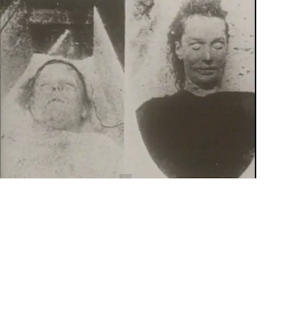
The principal subject of this documentary is Dracula, the story, legened and the man who inspired him Vlad the Impalar. It talks about the stories behind Vlad and how he inspired the vampire story. It also talks about hte history of the town Vlad was in, Vlads own history, how vampires myths could have started.
The film has many interviews with all people that could have presence in the analysis of Dracula. They interview peole form the town in which Dracula was born and lived. you find that Vlad the Impalara was a national hero there. They interview scholoars who talk baout Vlads life. They interviewed a vampire hunter as well.
When talking about Vlad the Impaler life, they often show clips from other films centered around Vlads life when talking about specific times in his life. Also they show paintings and drawings of Vlad and his conquest. When talking about Dracula the novel they show several shots from the film adaptations.With adtions of these shots they want us to expirence not only the film and words but also get a sence of what they are talking baout letting our sight help in the overall picture of who Vlad and Dracula were.
The voice over that the film uses is used to add additional knowledge that who they were interviewing did not fully convey at the time. Also the voice over is used as a transition at times. It is used so that multiple points could be brought together without seeming awkward.

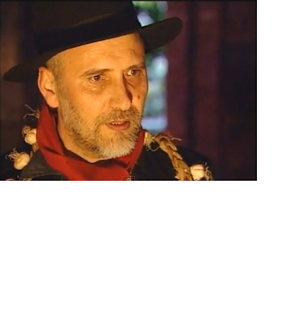 The documentary does not seem to have spontaneouse dialouge. The time the people are interviewed they are usually shown in an establishing shot and then introduced.
The documentary does not seem to have spontaneouse dialouge. The time the people are interviewed they are usually shown in an establishing shot and then introduced.The people interviewd in the film are citizens of the town where Vlad lived inorder to get an insight on public opinion of Vlad. Others are scholars who talk about the conquests of Vlad to help understand who he was. The scholars also talk about the life back in the 1500's to give insight into how cruel Vlad may have been. They bring in doctors to understand how the vampire myths may have been creating by talking about vampire like symptoms of the film.
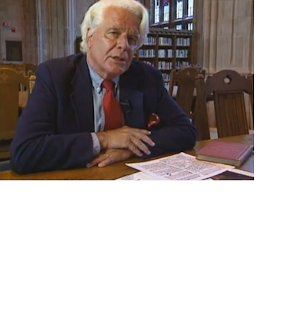 They use many paintings of Vlad, to show how t=he was seen in the ancient times.
They use many paintings of Vlad, to show how t=he was seen in the ancient times.Some of hte scenes are composed. when talking in the city Vlad was born in there is the presence of a statue of Vlad behind who is being interviewed.
The interviews the Documentary film maker uses are heavily edited. Many of the interviewers are brought up several times through out the length of the film. The way the film is edited is it starts with the idea of dracula, has people brought up about htat then slowly moves into Vlad, how Vlad came to power and his life, how vlad represented dracula and how vampires came about. Through out the film many people are brought up again as they have many points for the different topics.
When talking about torture, the undead and being buried alive the is a slight dramatic score going on in the background. Them music creates a more dangerous atmosphere around the information being presented.
The film maker do-sent change angels much. They usually start with an establishing shot of the interviewee then move to a close up of the the interviewee. From there the camera stays in a fixed position. At time the camera is angled different to show something behind the interviewee or to reveal something else.
Overall the documentary was very effective. It gave out valuble inforamtion of the start of Dracula the actual dracula and the implications the actual dracula has today. It also gave out valuble inforamtion on how vampire myths and legends may have been started and how they have evolved through out the ages
Friday, October 5, 2012
Pudovkins: concept on constructive editing was that each shot had to make a new point. It was not the shot itself that he cared for it was the juxtaposition of shots that he believed would create new meanings. belived only CU's and textures were acceptable, long shots were to close to reality and that a jumble of juxtaposition was a better concept of reality.The kuslhov effect is when you get the emotion not from the actors acting but instead by the juxtapositions. The viewer gets the emotional feeling once the correct objects have been put together in the film Eisenstein: montage was were he believed that film will be created by juxtaposing two contrasting opposites. He believed that all phenomena were subject to change. Smooth transition was not preferred instead harsh contract was better. He believed that by showing a thesis and antithesis that a new idea would be synthesized. in the odeasa steps the eisenstien style creates ambiguity of the film. It shows good then bad, bad the worse worse then good. There is no dialog. Allows viewers to synthesize own ideas about film by showing good with bad. Andrea bazins idea was realism. He belived film was the most real media. Belived montage was one of the many tools film makers had at there disposal. Belived a film became real because of its ambiguity. Allowed the viewers to make there own interpretations of the film. Belived classical cutting was to impsoing took away the viewrs ability to make own ideas. Used long shots and panning trucking and tilting rather than cutting.
The " Man with a Camera" is based off the kuslhov effect. It has sharp contrasts and not smooth transitions is aopen for interpretation. In bicycle theif it has more of a realist shooting with some of pudovkins concept of constructive editing. From the shots in bicycle thief it holds out long shots of bicycles back and forth, we get not much of a responce from the actor but from the holding of the scene we understand what the actor is going to do, steal the bike.
The " Man with a Camera" is based off the kuslhov effect. It has sharp contrasts and not smooth transitions is aopen for interpretation. In bicycle theif it has more of a realist shooting with some of pudovkins concept of constructive editing. From the shots in bicycle thief it holds out long shots of bicycles back and forth, we get not much of a responce from the actor but from the holding of the scene we understand what the actor is going to do, steal the bike.
Thursday, September 27, 2012
The character i choose was the Joker from the film the Dark Knight rises. The joker always dress in a purple pinstripe suite, with a green vest and blue shirt. His high class wardrobe provides a contrast to his facial makeup which is composed of white facepaint black eye shadow, green hair and an eerie ear to ear smile. The jokers wardrope and body language match his person: crazy. His wardrobe contradicts his face which gives the impression of chaos. His body language is he uses wild hand gestures and flips his tongue when he speaks. His persona is just chaos, he hardly ever does anything for personal gain he just does it because it will cause chaos. In this scene the Jokers purpose is just to demonstrate who he is. He tells people his idea of chaos and how gotham needs a new high class villain. He proceeds to demonstrate his philosophy on chaos by burning a giant stack of money they had just stolen. His only real character flaw is what his character is. His insanity is what puts him into danger and is what makes Batman try to stop him. The way the joker gets past his insanity is he really dosnt, but however his insanity almost saves him. since the joker wanted no monetary value from anything he did he just wanted to do it for the chaos it made it hard to stop him as there was nothing to hold against him.
Tuesday, September 18, 2012
The surreal photos of Martin Marcisovsky. This photo is one of the many surreal photos of the dubblin photographer. his photos show a world that seems non existent. They involve a single protagonist usualy with there backs turned towards the camera. The photos have there own scene of mystery to them as iit gives no back story of who is there or why the person is there, however the photos allow the viewer to develop there own ideas on what the photo is. Its vagueness allows them to create there own idea for why this lonely protagonist is walking in some strange desert. It gives the viewer the idea that they are lost and exploring some new spot in their own mind,
Subscribe to:
Comments (Atom)







